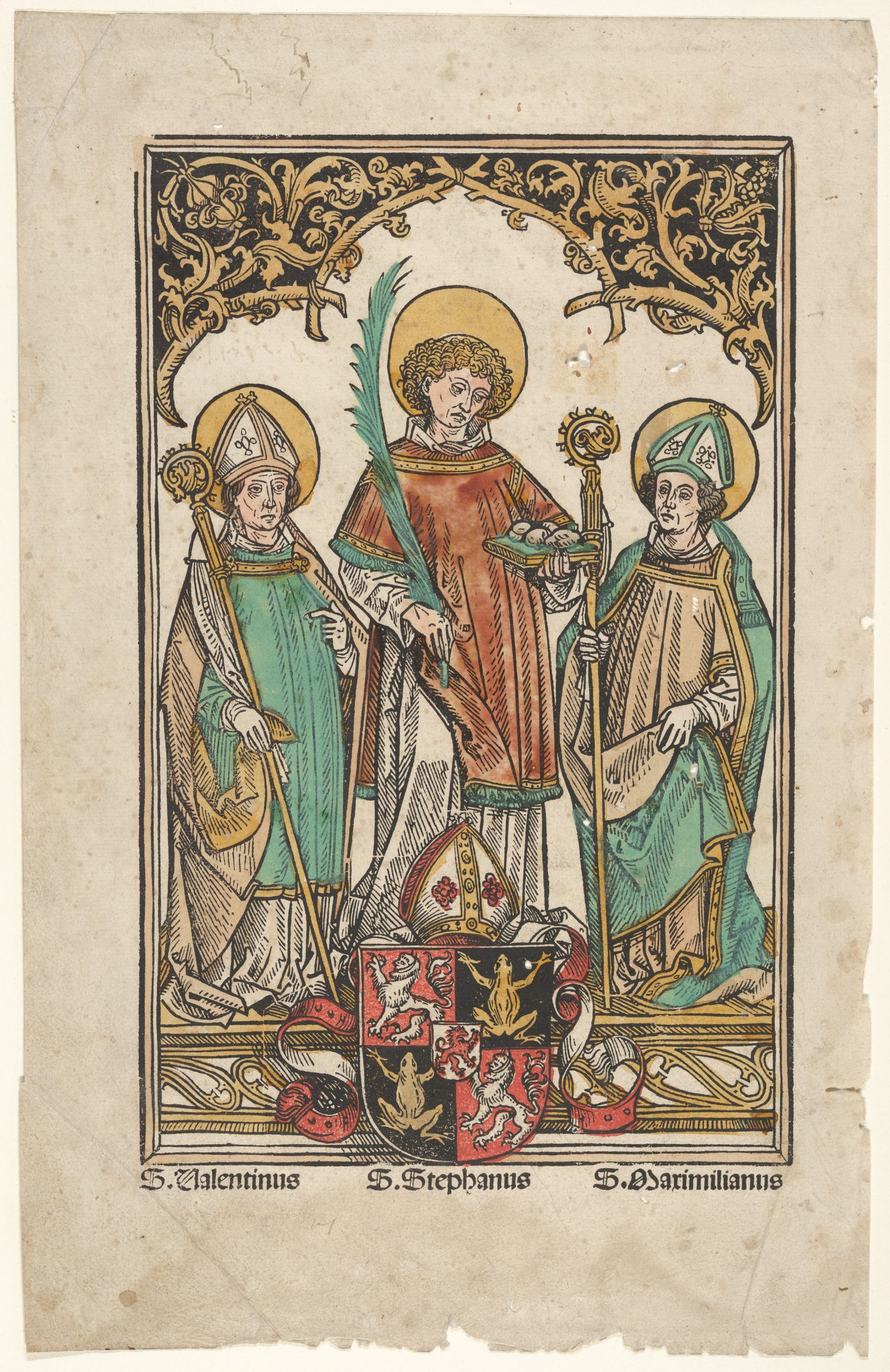
ABOUT THE ART
Burgkmair, Hans. Saints Valentine, Stephen, and Maximilian, the Patron Saints of Passau. 1503-5. Hand-colored woodcut, second state of two (Hollstein). Sheet: 13 3/8 × 8 9/16 in. (34 × 21.7 cm). Bequest of James Clark McGuire, 1930. Print. Accession Number: 31.54.411. New York. The Metropolitan Museum of Art.
At the center of the image stands Saint Stephen, depicted with the symbols of his martyrdom, while Saint Valentine and Saint Maximilian, the patron saints of Passau, flank him on the left and right respectively. The second state of the hand-colored woodcut includes the coat of arms of Bishop Wigeleus von Fröschel at the bottom center, which replaced the coat of arms of the previous bishop that was present in the first state. This woodcut was used as the frontispiece for the Passau Missal (Missale Pataviense) in the 1503 and 1505 editions published by Erhard Ratdolt in Augsburg.
Saint Valentine – February 14th
“Saint Valentine’s,” Geoffrey Chaucer poetically said, “is when every foul comes there to choose their mate.” It was this 14th-century poem that lifted St. Valentine from obscurity to romantic fame. Fairly soon, many poets were using St. Valentine’s Day as shorthand for romantic love. St. Valentine’s Day, like Candlemas, is a celebration of early spring and fertility with cultural roots going back to the Roman festival Lupercalia (so do Leprechauns, for that matter). It is a way of celebrating our place as human creatures in the creation cycle of nature.
The feast day of St. Valentine is a day to celebrate lovers by exchanging chocolates and cards. The story is that St. Valentine, when he was imprisoned, passed a card to his lover and signed it “from your Valentine,” beginning the tradition. Some say that he officiated at a wedding in prison before his execution. These, no doubt, are fanciful stories helping the day fit more with the theme of romance and early spring. The only thing that is known about the multiple St. Valentines (up to three are celebrated on this day) is that they were all martyrs of the early church put to death by Rome.
While this is not exactly the romantic story we were hoping for, it is a love story. It is the self-giving love of God poured upon the world in Christ Jesus that the martyrs lived out. The Valentines and other nameless martyrs are all remembered for modeling this self-giving love to the world.
Somehow, Chaucer’s opening line to the St. Valentine’s poem, “The Parliament of Fowls,” says it best:
“So short our lives, so hard the lessons, so difficult the tests, so sudden the final victory, so tenuous the hope of joy that so easily evaporates into fear – this is what I mean by Love.”

Chocolate Covered Strawberries
The sweetness of the chocolate is complemented by the slight tartness of the strawberries, making for a delicious treat that is both indulgent and refreshing.
Keep the screen of your device on
Ingredients
1 lb 1 strawberries (12- 15 medium sized strawberries)
6 oz 6 bittersweet chocolate, chopped
2 oz 2 white chocolate, chopped
Directions
- Wash and dry the strawberries. Line sheet pan with parchment paper.
- In heatproof bowl over a pan of simmering water (double boiler method – make sure water does not touch the bottom of the heatproof bowl), heat bittersweet chocolate until almost completely melted, stirring frequently. Remove from heat and stir until completely melted.
- Holding berries by stem, dip each strawberry until at least 2/3rd or 3/4th coated in chocolate, being sure to leave some red at the top. Allow excess chocolate to drip off.
- Place prepared strawberries on sheet pan and chill in fridge until chocolate is set, about 20 minutes.
- At the end of the chill time, repeat the double boiler method with the white chocolate.
- Remove berries from fridge. Using a fork, drizzle white chocolate over the chocolate covered strawberries. Chill again until white chocolate has set, another 15 minutes.